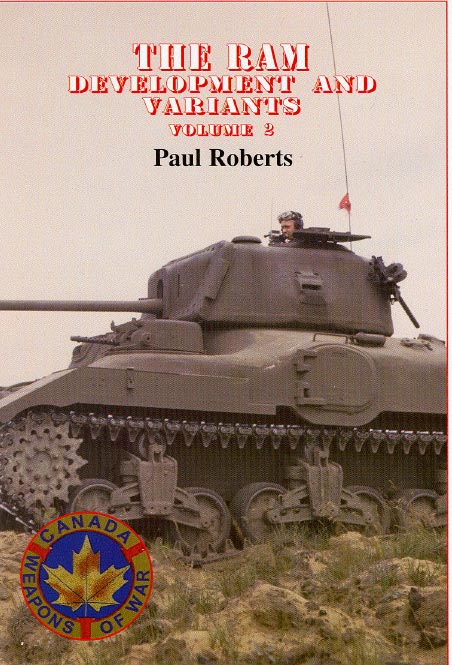"Weapons of War" Series;
The Ram Volume 2: Development and Variants
by Paul Roberts

Service Publications, Ottawa, Ontario, Canada, 2004; 24 pp. with B&W
photos and one painting diagram; price CDN $9.95; ISBN 1-894581-19-9 (http://www.servicepub.com)
Advantages: Continues coverage of a popular if underreported armored vehicle
series; photos are fresh and new, as is text
Disadvantages: No kit of this vehicle to model!
Rating: Highly Recommended
Recommendation: to all fans of Canadian or Allied WWII Armor, or "Shermaholics"
Some time ago Service Publications released the first volume in this
series, which covered the development and some of the general points of
interest on the Canadian derivative of the US M3 Medium Tank, the Ram.
In this book, Paul Roberts, well-known Canadian modeler and current president
of the Armor Modeling and Preservation Society, continues the text on
this interesting if under-modeled vehicle.
Backed up with a large number of fresh photos from the collection of
historian and modeler Barry Beldam, the book covers the development and
combat use – such as it was – of the Ram in service. It points
out that the Ram used as much as was practical from its "parent"
– the M3 – but changed most of the major components to suit
Canadian views of what a proper tank needed. The Mark II, the main production
version of the tank, used a 6-lb gun in place of the US tank's M5 37mm
gun, but adopted the gyrostabilizer used by that weapon and the later
M6 37mm gun. The hull evolved over the production run, eventually losing
the satellite turret on the left front side of the hull and the antiquated
side doors, but retained the same componentry. Alas, it had too small
a turret ring to permit an upgrade to the US M3 75mm gun later in its
career, and that doomed the tank to nearly sit on the sidelines of the
war in Europe.
However, the tank was used by Canadian regiments for training in England,
and was also the "volunteer" for some projects such as the development
of the LCM series of landing craft. The tank was successfully carried
by the LCM(1) version developed by Britain, and even proved the safety
of tank gunnery from the craft while afloat. Alas, it also showed that
this only worked well in still water, and thus the LCMs had to wait for
larger size and more flotation reserve to be used as "water taxis"
for tanks.
The tanks were also adapted to fit specialist functions, and this is
what gave them their combat debut and service. Having a reliable chassis,
the tank was used as a stripped-down version with a dummy gun as an artillery
OP; a plotting board and suitable comms gear was fitted, and it was used
as an armored forward observation post with good success.
The tank was also stripped of its turret and all internal components
for use as a "Kangaroo." But as this work shows, the "Kangaroos"
were more than just spartan: NO provision was made for the infantry's
carriage other than a big open hole in the top of the hull (the former
turret race). No storage for kit inside the hull was provided, nor were
any seats fitted. One must wonder if "riding" in such a vehicle
was really better than walking!
Other variants included the RAM ARV Mk. I and one prototype Mk. II, and
a Ram Kangaroo fitted with a flamethrower.
Overall, this book is a nice addition to any collector of US "Shermania"
(from the M3 and M4 Medium Tank family) as well as a good inclusion on
Canadian armor and its part in the war.
Thanks to Clive Law of Service Publications for the review copy.
Cookie Sewell
|